Urinary Incontinence Treatment Devices Market Size
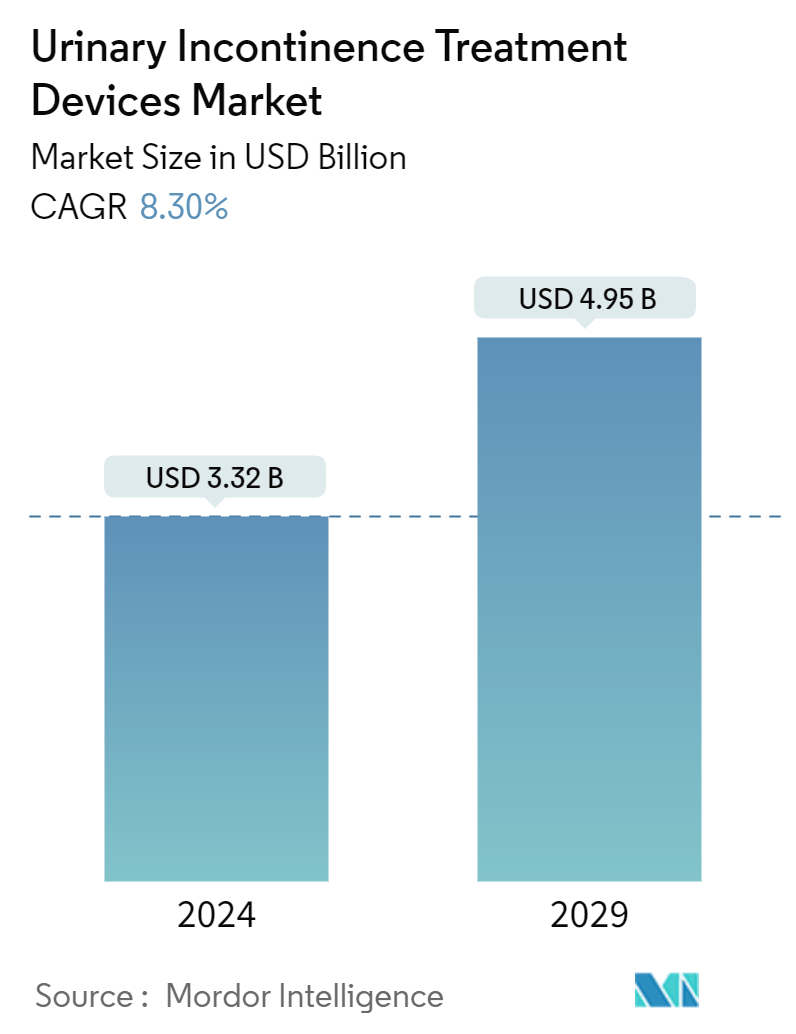
| Study Period | 2019 - 2029 |
| Market Size (2024) | USD 3.32 Billion |
| Market Size (2029) | USD 4.95 Billion |
| CAGR (2024 - 2029) | 8.30 % |
| Fastest Growing Market | Asia-Pacific |
| Largest Market | North America |
Major Players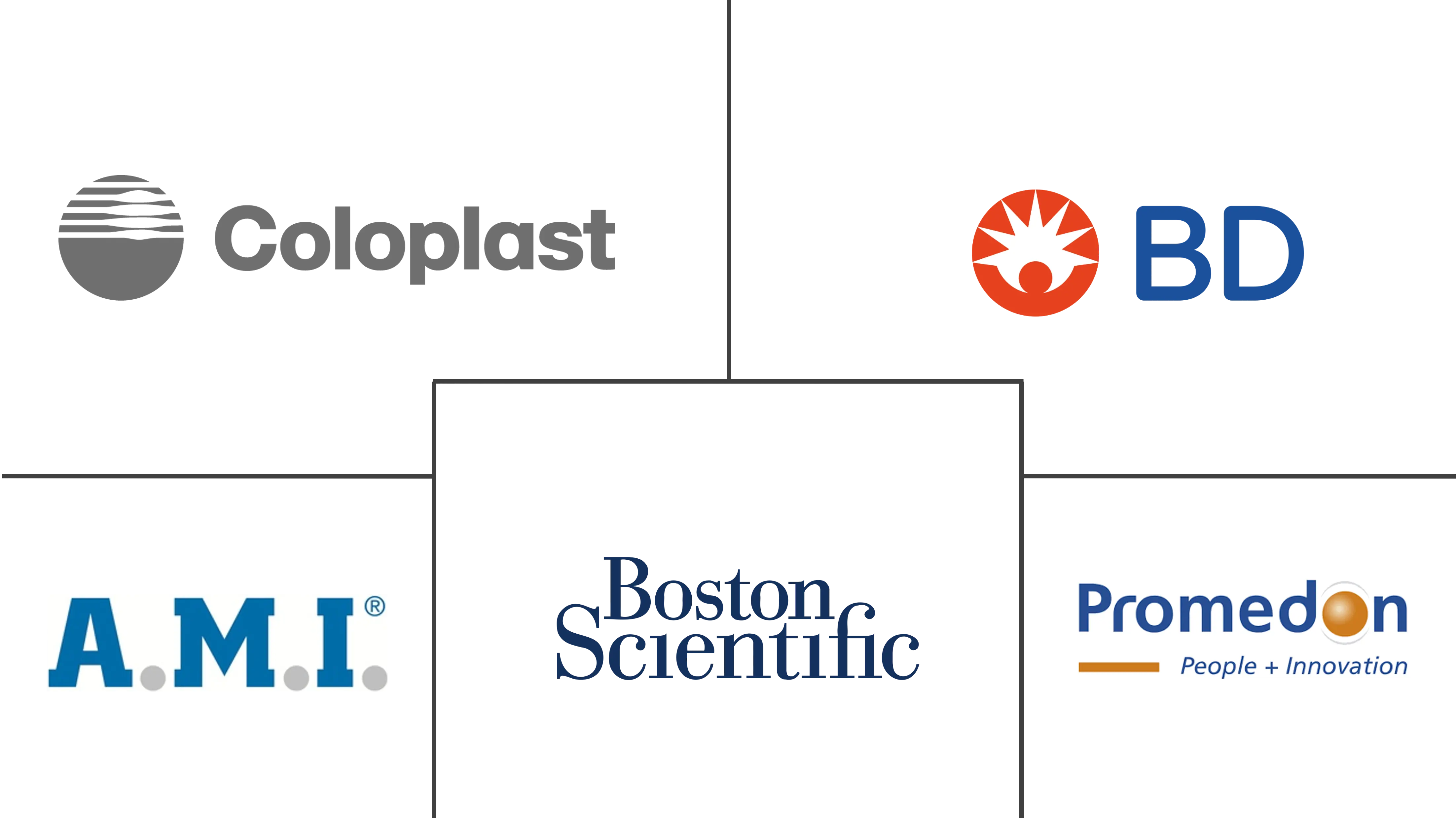
*Disclaimer: Major Players sorted in no particular order |
Urinary Incontinence Treatment Devices Market Analysis
The Urinary Incontinence Treatment Devices Market size is estimated at USD 3.32 billion in 2024, and is expected to reach USD 4.95 billion by 2029, growing at a CAGR of 8.30% during the forecast period (2024-2029).
Factors such as the increasing prevalence of urinary incontinence, the rise in the geriatric population, and the rise in demand for minimally invasive surgery and product development are expected to boost market growth.
The rising prevalence of urinary incontinence is one of the major factors driving market growth. For instance, according to an article published by SpringerLink in March 2022, a study was conducted in Sweden that mentioned that urinary incontinence (UI) was the involuntary loss of urine and had an estimated prevalence of about 25 to 45% among adult women. Thus, the high burden of urinary incontinence is expected to boost the adoption of urinary incontinence treatment devices.
Moreover, the rising geriatric population is another major factor driving market growth, as urinary incontinence is much more common in elderly people. For instance, according to the World Population Prospects 2022 Report published by the UN in 2022, the share of the global population aged 65 years or above was projected to rise from 10% in 2022 to 16% in 2050. By 2050, the number of people aged 65 years or over worldwide is projected to be more than twice the number of children under age five and about the same as the number of children under age 12. Thus, the rising geriatric population is expected to enhance market growth.
Furthermore, the rising developments by major market players are also expected to boost market growth. For instance, in March 2022, Medtronic announced that its investigational implantable tibial neuromodulation (TNM) device had been implanted in the first patient for its TITAN 2 pivotal study. The multicentre, prospective study is designed to assess the device's safety and efficacy in people with urinary incontinence-related overactive bladder (OAB).
Thus, the aforementioned factors, such as the rising prevalence of urinary continence, coupled with the rising geriatric population and the increasing developments by major market players, are expected to boost market growth. However, factors such as a lack of awareness about devices, the social stigma associated with the disease, and the risks and complications related to the procedures are expected to impede market growth over the forecast period.
Urinary Incontinence Treatment Devices Market Trends
Urethral Slings Segment Expected to Witness Healthy Growth Over the Forecast Period
Urethral sling surgery is also known as mid-urethral sling surgery. The sling material used may be muscle, ligament, or tendon tissue. It may also be composed of synthetic material, such as plastic compatible with body tissues, or absorbable polymer that disintegrates over time. The urethral slings segment is expected to witness growth as these are highly recommended for surgical treatment for stress urinary incontinence. Factors such as the rising prevalence of urinary incontinence, rising geriatric populations, and increasing developments by key market players are expected to boost segment growth.
According to an article published by PubMed Central in December 2022, a study was conducted in the United Arab Emirates that showed that the quality of life was affected by an estimated 90% of the patients suffering from urinary incontinence. Thus, the rising burden of urinary incontinence among women and the aging population is boosting the demand for urethral slings.
According to the 2023 update by AAre Urocare, the prevalence of UI was about half as much as in women and men. Approximately 3% to 11% of men were diagnosed with urinary incontinence, and urge incontinence was the most common type. Thus, the high burden of urinary incontinence in the country is expected to boost the adoption of urethral sling.
Moreover, according to the data updated by WHO in October 2022, it is estimated that by 2030, one in six people worldwide will be aged 60 years or over, and the share of the population aged 60 years and over will increase from 1 billion in 2020 to 1.4 billion in 2030. By 2050, the number of people aged 60 years and older will double to 2.1 billion. It is also estimated that the number of people aged 80 years or older is expected to triple between 2020 and 2050 to reach 426 million. As the geriatric population is often associated with urinary incontinence, the rising geriatric population is expected to boost market growth.
Thus, the aforementioned factors, such as the rising prevalence of urinary incontinence and the rising geriatric population, are expected to boost segment growth.
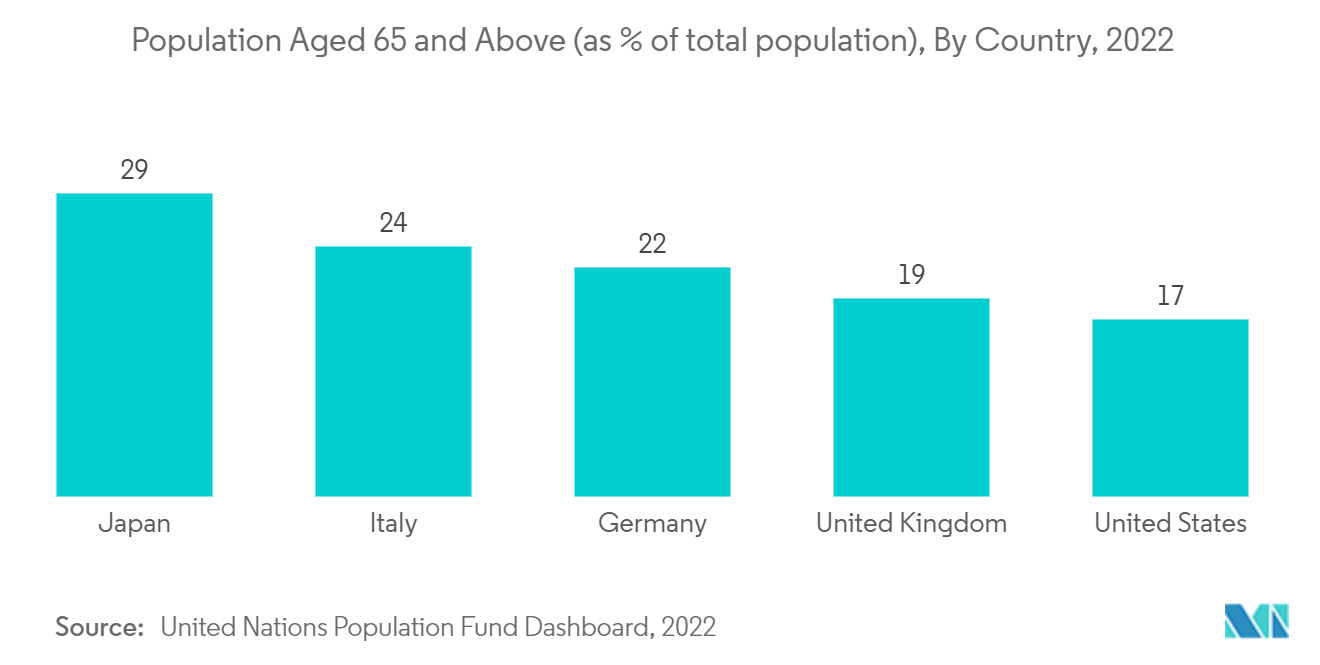
North America Expected to Hold a Significant Market Share over the Forecast Period
The major factors driving the market growth in North America are increases in the prevalence of urinary incontinence (UI), the geriatric population, and the demand for minimally invasive surgeries in the region.
For instance, according to an article updated by NCBI in August 2022, it was estimated that approximately 13 million Americans experience urinary incontinence annually, and the prevalence was 50% or greater among residents of nursing facilities. Similarly, according to an article published by Taylor & Francis Online in February 2023, a study was conducted in Mexico that examined the relationship between gender and the different urinary incontinence subtypes in community residents of the country in people aged 50 years old and above, it was found that in elderly females, mixed urinary incontinence had the highest incidence rate of 8.7%, which increased with age from 6.9% in 50 to 59-year-olds to 11.8% in 90-year-olds. Thus, the high prevalence of urinary incontinence is expected to boost market growth in the region.
Moreover, the rising geriatric population is also a major factor in market growth. For instance, according to the data published by Statistics Canada in July 2022, around 7,330,605 people were 65 years of age or older in Canada, which accounted for 18.8% of the total population.
Strategies adopted by major companies, such as research and development, mergers and acquisitions, and product launches, to strengthen their market position are other factors driving the growth of the market studied. For instance, in January 2022, Owens & Minor Inc. and Apria Inc. entered a definitive agreement to acquire Apria. The acquisition was anticipated to broaden the company’s incontinence and ostomy portfolio. Further, in May 2022, BlueWind Medical Ltd announced the closing of a USD 64 million Series B funding round. The funding was raised for the development of the innovative RENOVA iStim implantable tibial neuromodulation device under investigation for the treatment of urgency incontinence alone or in combination with urinary urgency and/or urinary frequency.
Therefore, the aforementioned factors, such as the rising prevalence of urinary incontinence, the rising geriatric population, and the increasing developments by key market players, are expected to boost the urinary incontinence treatment devices market in the region over the forecast period.
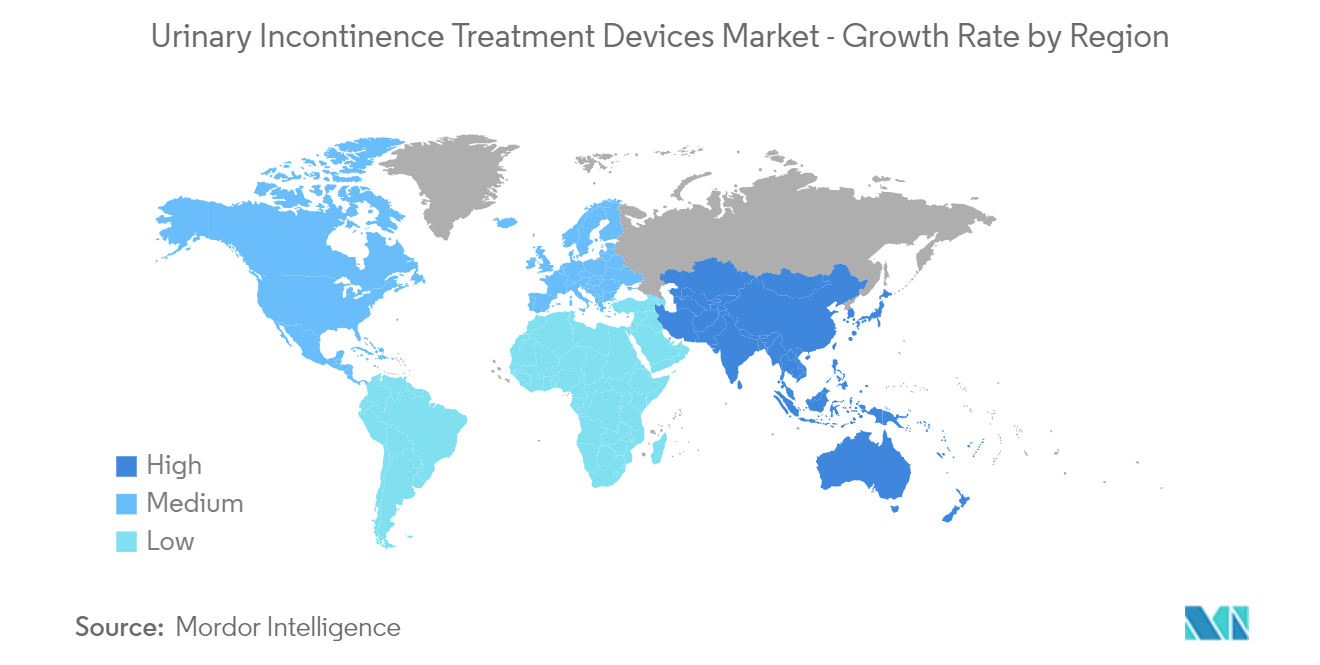
Urinary Incontinence Treatment Devices Industry Overview
The urinary incontinence treatment devices market is semi-consolidated in nature. Some of the companies currently dominating the market are Boston Scientific Corporation, Becton, Dickinson and Company, Coloplast Corp., Promedon Group, AMI GmbH, Johnson & Johnson (Ethicon), Zephyr Surgical Implants, Medtronic PLC, Caldera Medical Inc., Hollister Incorporated B Braun SE, and ConvaTec Group PLC.
Urinary Incontinence Treatment Devices Market News
-
Promedon Group
-
Boston Scientific Corporation
-
A.M.I. GmbH
-
Coloplast Corp
-
Becton, Dickinson and Company
*Disclaimer: Major Players sorted in no particular order
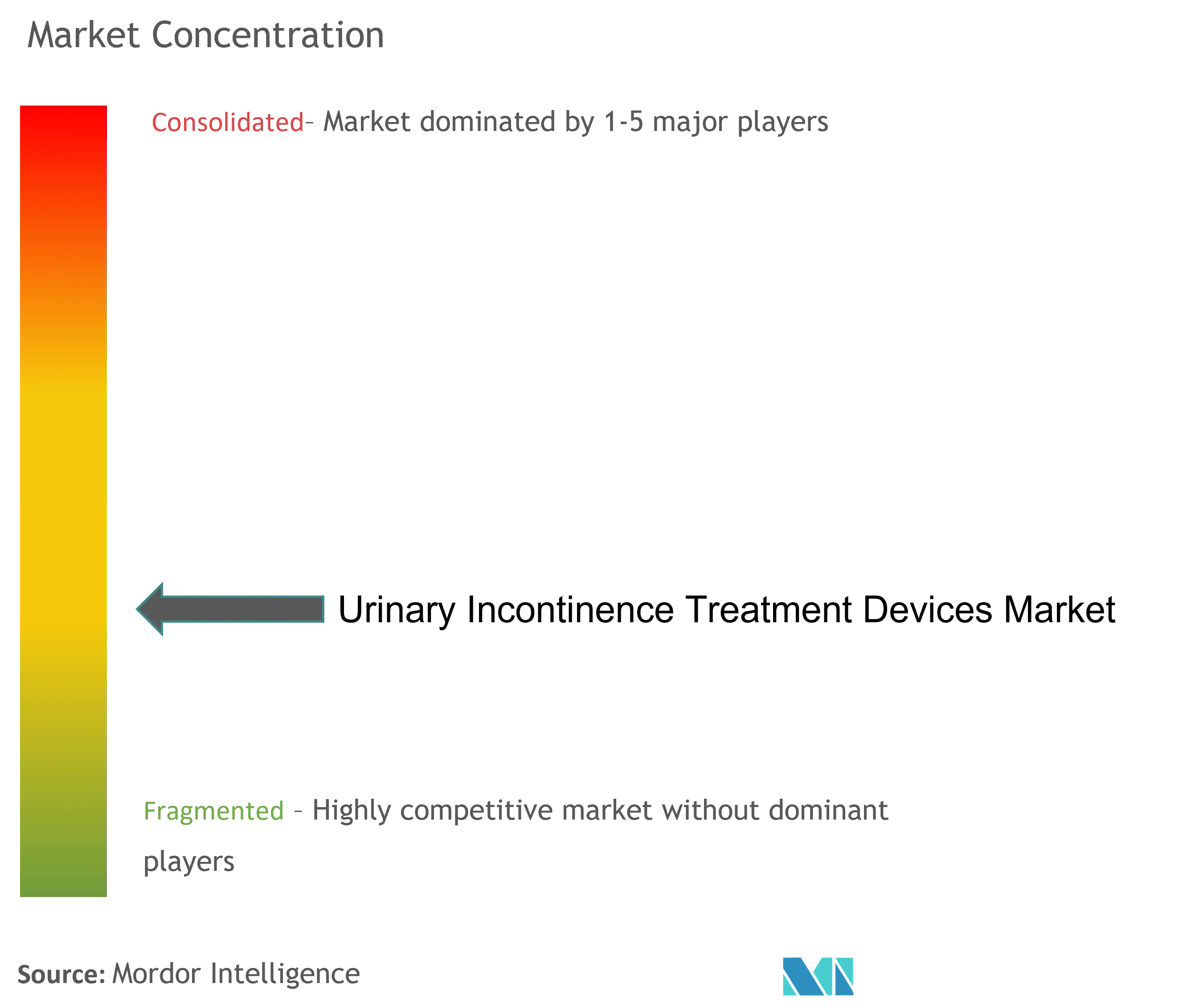
Urinary Incontinence Treatment Devices Market News
- April 2024: Zydus Lifesciences introduced a generic medication for overactive bladder treatment in the United States. Following the final approval from the US Food and Drug Administration (USFDA), the company rolled out its Mirabegron extended-release tablets, available in a 25 mg strength, as reported in a regulatory filing by Zydus Lifesciences.
- June 2023: Urologists at the University of Iowa Health Care introduced a novel treatment for urgent urinary incontinence, characterized by a sudden and uncontrollable urge to urinate, often leading to leakage.
Urinary Incontinence Treatment Devices Market Report - Table of Contents
1. INTRODUCTION
- 1.1 Study Assumption and Market Definition
- 1.2 Scope of the Study
2. RESEARCH METHODOLOGY
3. EXECUTIVE SUMMARY
4. MARKET DYNAMICS
- 4.1 Market Overview
-
4.2 Market Drivers
- 4.2.1 Increasing Prevalence of Urinary Incontinence and Rise in Geriatric Population
- 4.2.2 Rise in Demand for Minimally Invasive Surgery and Product Development
-
4.3 Market Restraints
- 4.3.1 Lack of Awareness about Devices and Social Stigma Associated with the Disease
- 4.3.2 Risks and Complications from the Procedures
-
4.4 Porter's Five Forces Analysis
- 4.4.1 Threat of New Entrants
- 4.4.2 Bargaining Power of Buyers/Consumers
- 4.4.3 Bargaining Power of Suppliers
- 4.4.4 Threat of Substitute Products
- 4.4.5 Intensity of Competitive Rivalry
5. MARKET SEGMENTATION (Market Size by Value - USD)
-
5.1 By Product
- 5.1.1 Urethral Slings
- 5.1.2 Electrical Stimulation Devices
- 5.1.3 Artificial Urinary Sphincters
- 5.1.4 Catheters and Other Products
-
5.2 By End User
- 5.2.1 Hospitals
- 5.2.2 Ambulatory Surgical Centers
- 5.2.3 Other End Users
-
5.3 By Geography
- 5.3.1 North America
- 5.3.1.1 United States
- 5.3.1.2 Canada
- 5.3.1.3 Mexico
- 5.3.2 Europe
- 5.3.2.1 Germany
- 5.3.2.2 United Kingdom
- 5.3.2.3 France
- 5.3.2.4 Italy
- 5.3.2.5 Spain
- 5.3.2.6 Rest of Europe
- 5.3.3 Asia-Pacific
- 5.3.3.1 China
- 5.3.3.2 Japan
- 5.3.3.3 India
- 5.3.3.4 Australia
- 5.3.3.5 South Korea
- 5.3.3.6 Rest of Asia-Pacific
- 5.3.4 Middle East and Africa
- 5.3.4.1 GCC
- 5.3.4.2 South Africa
- 5.3.4.3 Rest of Middle East and Africa
- 5.3.5 South America
- 5.3.5.1 Brazil
- 5.3.5.2 Argentina
- 5.3.5.3 Rest of South America
6. COMPETITIVE LANDSCAPE
-
6.1 Company Profiles
- 6.1.1 Boston Scientific Corporation
- 6.1.2 Becton, Dickinson and Company
- 6.1.3 Colopast Group
- 6.1.4 PROMEDON GmbH
- 6.1.5 AMI GmbH
- 6.1.6 Johnson & Johnson (Ethicon)
- 6.1.7 Zephyr Surgical Implants
- 6.1.8 Medtronic
- 6.1.9 Caldera Medical Inc.
- 6.1.10 Hollister Incorporated
- 6.1.11 B Braun SE
- 6.1.12 ConvaTec Group PLC
- *List Not Exhaustive
7. MARKET OPPORTUNITIES AND FUTURE TRENDS
** Subject To AvailablityUrinary Incontinence Treatment Devices Industry Segmentation
As per the scope of the report, urinary incontinence is a condition that defines any involuntary leakage of urine. The condition is categorized according to its underlying cause. Urinary incontinence results from difficulties in either filling, storing, or emptying the bladder, and some people may even suffer from a combination of these problems. The urinary incontinence treatment devices market is segmented by product, end user, and geography. By product, the market is segmented into urethral slings, electrical stimulation devices, artificial urinary sphincters, and catheters and other products. By end user, the market is segmented into hospitals, ambulatory surgical centers, and other end users. By geography, the market is segmented into North America, Europe, Asia-Pacific, the Middle East and Africa, and South America. The report also covers the estimated market sizes and trends for 17 countries across major regions globally. The report offers the value (USD) for the above segments.
| By Product | Urethral Slings | |
| Electrical Stimulation Devices | ||
| Artificial Urinary Sphincters | ||
| Catheters and Other Products | ||
| By End User | Hospitals | |
| Ambulatory Surgical Centers | ||
| Other End Users | ||
| By Geography | North America | United States |
| Canada | ||
| Mexico | ||
| By Geography | Europe | Germany |
| United Kingdom | ||
| France | ||
| Italy | ||
| Spain | ||
| Rest of Europe | ||
| By Geography | Asia-Pacific | China |
| Japan | ||
| India | ||
| Australia | ||
| South Korea | ||
| Rest of Asia-Pacific | ||
| By Geography | Middle East and Africa | GCC |
| South Africa | ||
| Rest of Middle East and Africa | ||
| By Geography | South America | Brazil |
| Argentina | ||
| Rest of South America |
Urinary Incontinence Treatment Devices Market Research FAQs
How big is the Urinary Incontinence Treatment Devices Market?
The Urinary Incontinence Treatment Devices Market size is expected to reach USD 3.32 billion in 2024 and grow at a CAGR of 8.30% to reach USD 4.95 billion by 2029.
What is the current Urinary Incontinence Treatment Devices Market size?
In 2024, the Urinary Incontinence Treatment Devices Market size is expected to reach USD 3.32 billion.
Who are the key players in Urinary Incontinence Treatment Devices Market?
Promedon Group, Boston Scientific Corporation, A.M.I. GmbH, Coloplast Corp and Becton, Dickinson and Company are the major companies operating in the Urinary Incontinence Treatment Devices Market.
Which is the fastest growing region in Urinary Incontinence Treatment Devices Market?
Asia-Pacific is estimated to grow at the highest CAGR over the forecast period (2024-2029).
Which region has the biggest share in Urinary Incontinence Treatment Devices Market?
In 2024, the North America accounts for the largest market share in Urinary Incontinence Treatment Devices Market.
What years does this Urinary Incontinence Treatment Devices Market cover, and what was the market size in 2023?
In 2023, the Urinary Incontinence Treatment Devices Market size was estimated at USD 3.04 billion. The report covers the Urinary Incontinence Treatment Devices Market historical market size for years: 2019, 2020, 2021, 2022 and 2023. The report also forecasts the Urinary Incontinence Treatment Devices Market size for years: 2024, 2025, 2026, 2027, 2028 and 2029.
Europe Neurology Monitoring Industry Report
The Urinary Incontinence Treatment Devices Market Report provides a comprehensive industry overview segmented by product types including urethral slings, electrical stimulation devices, artificial urinary sphincters, and catheters and other products. The report also segments the market by end users such as hospitals, ambulatory surgical centers, and other end users. Additionally, the report covers geographical segmentation including North America, Europe, Asia-Pacific, Middle East and Africa, and South America, offering valuable market data and industry statistics.
The market forecast and market growth aspects are thoroughly analyzed, providing insights into the market value and market segmentation. The industry analysis includes a detailed review of market trends, market leaders, and market predictions. The report also highlights the industry size, industry trends, and industry outlook, offering a clear market overview.
The report example and report pdf are available for download, providing a sample of the industry research and market review. The report includes market analysis and industry sales, giving a comprehensive view of the market outlook and market predictions. The industry reports and industry information are crucial for understanding the market dynamics and growth rate.
The market forecast outlook and historical overview are included in the report, providing a detailed industry analysis. The industry research and industry sales data are essential for understanding the market trends and market growth. The industry statistics and market data provide a clear picture of the market segmentation and market value.
Overall, the Urinary Incontinence Treatment Devices Market Report is a valuable resource for research companies and industry professionals, offering a detailed market review and market predictions. The report includes all the necessary industry information and market data, making it an essential tool for understanding the market dynamics and growth rate.



